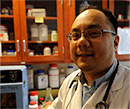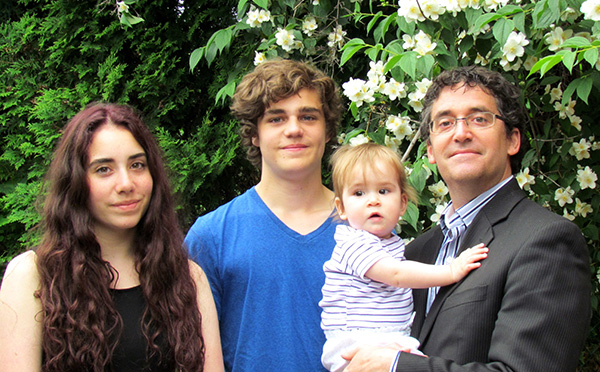The Mystery Infection: from Laboratory to Bedside
For eight years, Martin Liard suffered from an undiagnosed mass in his brain. His case was a mystery to some of the best medical specialists in Montreal—that is, until he met Dr. Donald Cuong Vinh, a world-renowned Infectious Disease specialist and researcher at the McGill University Health Centre (MUHC).
Dr. Vinh: on the genetics trail
Dr. Vinh studies genetic defects of the immune system and established the Infectious Disease Susceptibility Program at the Montreal General Hospital of the MUHC. His translational research program (which focuses on applying the findings of basic research directly to patient care) seeks to understand why the genetic make-up of certain individuals leaves them more vulnerable to rare, severe or recurrent infections.

Dr. Vinh is sometimes compared to Dr. Gregory House of the popular television series. Like House, Dr. Vinh has a reputation across the country for his interest in the most atypical medical conditions within his field of practice. “I may have a few things in common with him, such as encouraging my team of residents to venture off the beaten path, but I’d like think they find me a nicer person than he is!” he jokes.
Dr. Vinh’s publications and presentations on Liard’s case have given rise to a great deal of hope in the world’s scientific community. In addition, he has identified this same genetic immune deficiency in other francophone families and is digging deeper into the subject with assistance from the Fondation du grand défi Pierre Lavoie.
A medical puzzle
Until the age of 30, Liard, a geologist and father of two small children, was active and in good health. But in 2002, after fainting and experiencing serious speech problems, he learned he had a mass in his brain two centimetres in diameter.
Eight years of medical investigations followed, during which Liard suffered difficulties with memory and language, headaches and even epileptic seizures. All the while, the mass slowly continued to grow. “The doctors quickly ruled out cancer, because a tumour of that size would have had devastating effects. They thought it might be an abscess, bacteria or virus, such as the AIDS virus,” explains Liard. “Martin has to be the most-tested person for AIDS in all of Quebec!” says his wife, Marie-Noël Côté. Each time, the tests and biopsies came back negative.
In 2008, a lumbar puncture (a diagnostic to collect cerebrospinal fluid) produced alarming results: it showed Liard had an infection involving his brain and was in grave danger. The mass, which had grown to almost four centimetres in diameter, was then removed and examined in the laboratory, where physicians were shocked to discover the cause was a fungal infection. “It was so unusual to see a fungus lodge itself in the brain that one of my doctors felt there must have been an error made in the lab,” states Liard.
Despite the surgery, the infection did not completely disappear. Large doses of an anti-fungal drug improved the patient’s condition but did not cure him. “I was not as ill anymore, and I was able to keep working, but I ended up having to be hospitalized for a few weeks each year. Then, in the fall of 2011, things really started to go downhill,” recalls Liard.
The meeting with Dr. Vinh
As the result of an Internet search, Liard and his wife found Sylvie Carle, a pharmacist at the MUHC who studied anti-fungal drugs. She immediately referred them to Dr. Vinh, who rapidly discovered that Liard had a mutation in the CARD9 gene that prevented him from fighting a fungus infection. With Liard’s consent, Dr. Vinh designed a research plan and examined the patient’s cells in the laboratory in order to better understand – on both a molecular and cellular level – how the CARD9 mutation was making his patient ill.
In late 2011, Liard had another brush with death and was hospitalized for three months. Dr. Vinh administered an aggressive treatment of amphotericin B, a drug designed to attack systemic fungal infections. The treatment saved Liard’s life.
Next, based on the results of his laboratory experiments, Dr. Vinh suggested that Liard begin an experimental treatment to “awaken” his immune system and prevent a recurrence. Dr. Vinh was working on the assumption that the mutation had weakened the patient’s immune defense cells and that these cells were therefore unable to produce the protein (cytokine) needed to respond to the fungal infection.
In order to monitor and document the situation, Dr. Vinh asked Liard to undergo regular lumbar punctures. “After eight months of treatment, Mr. Liard’s condition had dramatically improved, and the white blood cell count, protein levels and glucose levels in his cerebrospinal fluid were normal for the first time in almost seven years! One might have thought he was cured,” explains Dr. Vinh. “However, when we stopped his medication, the infection unfortunately returned. So we resumed the treatment, and this rectified the situation.”
Family: an invaluable resource
Today, Liard is fully appreciating the time he spends with his family, which grew last year with the arrival of baby Adèle. Twenty months after starting his immune system treatment, he remains on medication, and his condition is very stable.
“We were extremely lucky to meet Dr. Vinh,” affirms Côté, who was by her husband’s side throughout his illness, monitoring his care at all times.
“Dr. Vinh saved my life, and my family saved me as well,” says Liard. “Dr. Vinh has truly gone above and beyond in treating me, Marie-Noël has helped me through the entire ordeal, and my children, who today are 15 and 17, have been an extraordinary source of motivation.”

Family picture - Camille (17), Stephen (15), Adele (14 months) and their dad, Martin Liard.